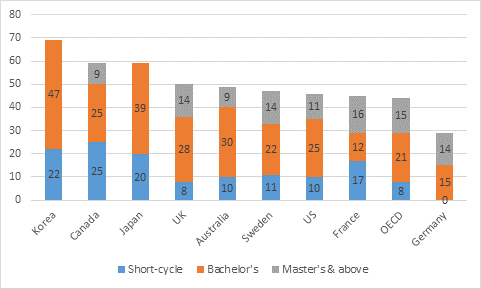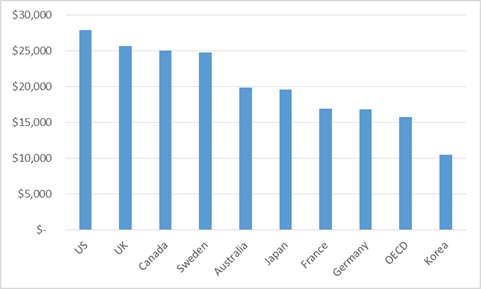The OECD’s annual datapalooza-tastic publication Education at a Glance was released yesterday. The pdf is available for free here. Let me take you through a couple of the highlights around Higher Education.
For the following comparisons, I show Canada against the rest of the G7 (minus Italy because honestly, economically, who cares?), plus Australia because it’s practically our twin, Korea because it’s cool, Sweden because someone always asks about Scandinavia and the OECD average because hey that just makes sense. First off, let’s look at attainment rates among inhabitants 25-34. This is a standard measure to compare how countries have performed in the recent past in terms of providing access to education.
Figure 1: Attainment Rates, 25-34 years olds, selected OECD countries
*Data for Master’s & above not provided separately for Korea and Japan, and is included in Bachelor’s
Education-fevered Korea is light-years ahead of everyone else on this measure, with 69% of its 25-34 yr old population attaining some kind of credential, but Canada is still close to the top at 59%. In fact we’re right at the top if you look just at short-cycle (i.e. sub-baccalaureate) PSE (see previous comments here about Canada’s world-leading strengths in College education); in terms of university attainment alone, our 34% is slightly below the OECD average of 36%.
Now let’s turn to finances. Figure 2 shows total public and private expenditure on Tertiary educational institutions.
Figure 2: Public and Private Expenditures on Tertiary Institutions, as a Percentage of GDP, Selected OECD Countries
Canada spends 2.5% of GDP on institutions, just below the US but ahead of pretty much everybody else, more than 50% higher than the OECD average. For those of you who have spent the last couple of years arguing how great Germany because of free tuition is and why can’t Canadian governments spend money like Germany, the answer is clearly they can. All they would need to do is cut spending by about 30%.
(If you’re wondering how UK claims 58% of all money in higher ed comes from government when the latest data from Universities UK shows it to be 25%, the answer I think is that this is 2013 data, when only 1/3 of the shift from a mainly state-based university funding system to mainly student-based funding system had been completed)
Turning now to the issue of how that money is split between different parts of the tertiary sector, here we see Canada’s college sector standing out again: by some distance, it receives more funding than any other comparable sector in the OECD (with 0.9% of GDP in funding). The university sector, by contrast, gets only 1.6% of GDP, which is closer to the OECD average of 1.4%.
Figure 3: Expenditure on Tertiary Institutions, by sector, as a Percentage of GDP, selected OECD countries
*US data not available for short-course, 2.6% is combined total
Now this is the point where some of you will jump up and say “see, Usher? We’re only barely above the OECD average! Canadian universities aren’t as well-funded as you usually make out.” But hold on. We’re talking % of GDP here. And Canada, within the OECD is a relatively rich country. And, recall from figure 1 that out university attainment rate is below the OECD average, which means those dollars are being spread over fewer students. So when you look just at expenditures per student in degree-level programs, you get the following:
Figure 4: Annual Expenditures per Student in $US at PPP, Degree-level Programs only, Selected OECD Countries
Again, Canada is very close to the top of the OECD charts here: at just over $25,000 US per student we spend over 50% more per student than the OECD average (and Germany, incidentally – just sayin’).
So, yeah, I’m going to give you my little sermon again: Canada’s is not an underfunded university system by any metric that makes the remotest bit of sense. If we’re underfunded, everyone’s underfunded, which kind of robs the term of meaning.
That doesn’t mean cuts are easy: our system is rigid and brittle and even slowing down the rate of increase of funds causes problems. But Perhaps if we directed even a fraction of the attention we pay to “underfunding” to the problem of our universities’ brittleness we might be on our way to a better system.
I won’t hold my breath.





 Tweet this post
Tweet this post
